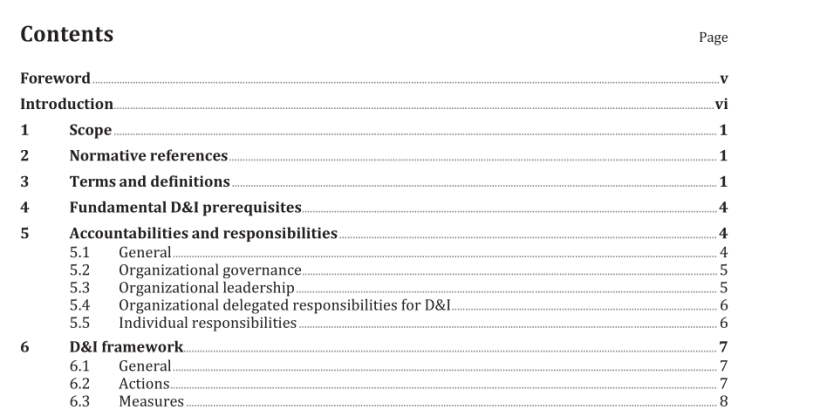ISO 30415:2021 pdf download – Human resource management — Diversity and inclusion.
1 Scope This document provides guidance on D&I for organizations, including their governance body, leaders, workforce and recognized representatives, and other stakeholders. It is intended to be scalable to the needs of all types of organizations in different sectors, whether in public, private, government or non- governmental organizations (NGO), regardless of size, type, activity, industry or sector, growth phase, external influences and country-specific requirements. This document presents fundamental prerequisites for D&I, associated accountabilities and responsibilities, recommended actions, suggested measures and potential outcomes. It recognizes that each organization is different and that decision makers need to determine the most appropriate approach to embedding D&I in their organization, based on the organization’s context and any disruptive challenges that emerge. This document does not address the specific aspects of relations with labour unions or work councils, or country-specific compliance, legal requirements or litigation. 2 Normative references The following documents are referred to in the text in such a way that some or all of their content constitutes requirements of this document. For dated references, only the edition cited applies. For undated references, the latest edition of the referenced document (including any amendments) applies. ISO 30400, Human resource management — Vocabulary
5.2 Organizational governance To ensure that the organization’s D&I principles and objectives are aligned with its vision, mission, values and strategy, its governing body should have accountability for: — directing senior leaders to establish D&I principles and objectives, and allocation of resources to achieve them; — demonstrating commitment to D&I and role modelling behaviours that are consistent with D&I principles, shared values and beliefs; — challenging and addressing behaviour that is inconsistent with D&I principles and ensuring that people who challenge inappropriate behaviour, and those who are affected by it, are protected and supported; and — holding senior leaders to account when evaluating the organization’s D&I opportunities and risks, and reviewing performance and progress in achieving D&I objectives and the impact of their outcomes.
5.4 Organizational delegated responsibilities for D&I People who are accountable for managing functional areas of the organization should have delegated responsibility for: — ensuring that D&I principles are embedded in functional systems, policies, processes and practices; — sharing D&I knowledge, skills and expertise, and providing advocacy and guidance on policies, processes and practices that promote a diverse and inclusive organizational culture; — demonstrating and role modelling inclusive behaviours; — deploying resources to respond to opportunities, risks, constraints and challenges in order to achieve D&I objectives; — fostering an inclusive and diverse workplace by enabling access and adjustments to increase participation of demographically under-represented groups; — ensuring policies, processes, practices and decisions about people, as they move into, through and out of the organization, are evidence-based and supported by checks and balances to mitigate the effects of bias, including any in existing and emerging technologies; — promoting the organization’s D&I principles and objectives through all stages of the human resource management life cycle; — facilitating open channels of communication so that diverse perspectives are received with respect and without prejudice; — enabling a safe environment for D&I issues, concerns and complaints to be raised, and ensuring policies, processes and practices are fairly applied for all stakeholders, including whistle-blowers; — ensuring that stakeholder feedback is considered when monitoring the implementation of policies, processes and practices to identify D&I impacts, outcomes, challenges, constraints and trends;
6 D&I framework 6.1 General A D&I framework is a supporting structure of interrelated components, which organizations can employ to contextualize, manage and promote inclusion strategically and cross-functionally. An illustration of organizational D&I ( Figure 1), which is used to structure this document, presents a D&I framework as a central component, emphasizing its coordinating function in the context of a plan, do, check, review approach. The D&I prerequisites in Clause 4 are fundamental to the development of an organization’s D&I framework, which recognizes its organizational context and the need for alignment with its vision, mission, values, objectives and systems. An organization’s D&I framework can incorporate and articulate: — D&I principles and objectives; — accountabilities and responsibilities; — D&I actions related to, for example, its HR management life cycle, supply chain, products and services, and relationships with external stakeholders; — valid and reliable quantitative and qualitative measures; — D&I opportunities and risks, including those related to the use of technologies and automated systems; and — potential D&I outcomes and impacts on different stakeholders.
